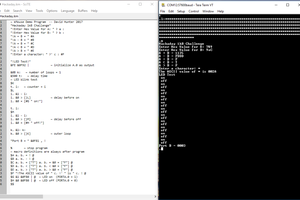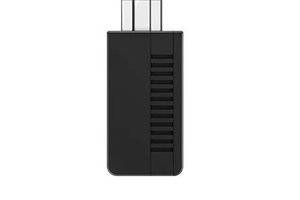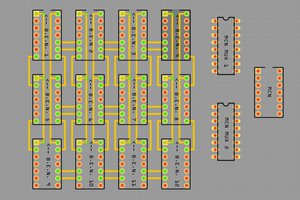0%
0%
This will be useless except for reference.
To make the experience fit your profile, pick a username and tell us what interests you.
We found and based on your interests.
;#pragma once ; CIS - 261 ; IO.H -- header file for I / O macros ; 32 - bit version for flat memory model .NOLIST; turn off listing .386 EXTRN itoaproc : near32, atoiproc : near32 EXTRN dtoaproc : near32, atodproc : near32 EXTRN inproc : near32, outproc : near32 EXTRN szlenproc : near32 itoa MACRO dest, source, xtra;; convert integer to ASCII string IFB .ERR EXITM ENDIF IFNB .ERR EXITM ENDIF push ebx;; save EBX mov bx, source push bx;; source parameter lea ebx, dest;; destination address push ebx;; destination parameter call itoaproc;; call itoaproc(source, dest) pop ebx;; restore EBX ENDM atoi MACRO source, xtra;; convert ASCII string to integer in AX ;; offset of terminating character in ESI IFB .ERR EXITM ENDIF IFNB .ERR EXITM ENDIF push ebx;; save EBX lea ebx, source;; source address to EBX push ebx;; source parameter on stack call atoiproc;; call atoiproc(source) pop ebx;; parameter removed by ret ENDM dtoa MACRO dest, source, xtra;; convert double to ASCII string IFB .ERR EXITM ENDIF IFNB .ERR EXITM ENDIF push ebx;; save EBX mov ebx, source push ebx;; source parameter lea ebx, dest;; destination address push ebx;; destination parameter call dtoaproc;; call dtoaproc(source, dest) pop ebx;; restore EBX ENDM atod MACRO source, xtra;; convert ASCII string to integer in EAX ;; offset of terminating character in ESI IFB .ERR EXITM ENDIF IFNB .ERR EXITM ENDIF lea eax, source;; source address to EAX push eax;; source parameter on stack call atodproc;; call atodproc(source) ;; parameter removed by ret ENDM output MACRO string, xtra;; display string IFB .ERR EXITM ENDIF IFNB .ERR EXITM ENDIF push eax;; save EAX lea eax, string;; string address push eax;; string parameter on stack call outproc;; call outproc(string) pop eax;; restore EAX ENDM input MACRO dest, length, xtra;; read string from keyboard IFB .ERR EXITM ENDIF IFNB .ERR EXITM ENDIF push ebx;; save EBX lea ebx, dest;; destination address push ebx;; dest parameter on stack mov ebx, length;; length of buffer push ebx;; length parameter on stack call inproc;; call inproc(dest, length) pop ebx;; restore EBX ENDM szlen MACRO string, xtra;; get string length IFB .ERR EXITM ENDIF IFNB .ERR EXITM ENDIF lea eax, string;; string address push eax;; string parameter on stack call szlenproc;; call szlenproc(string) ENDM .NOLISTMACRO; suppress macro expansion listings .LIST; begin listing
This is not my code! this is from http://www.c-jump.com/bcc/c261c/CIS261syllabus.html
; CIS-261
; implementation of I/O procedures called by macros in io.obj
; flat memory model version
.386
.MODEL FLAT
PUBLIC itoaproc, atoiproc, dtoaproc, atodproc, outproc, inproc, szlenproc
.CODE
; itoaproc(source, dest)
; convert integer (source) to string of 6 characters at given destination address
itoaproc PROC NEAR32
push ebp ; save base pointer
mov ebp, esp ; establish stack frame
push eax ; Save registers
push ebx ; used by
push ecx ; procedure
push edx
push edi
pushf ; save flags
mov ax, [ebp+12] ; first parameter (source integer)
mov edi, [ebp+8] ; second parameter (dest offset)
ifSpecial: cmp ax,8000h ; special case -32,768?
jne EndIfSpecial ; if not, then normal case
mov BYTE PTR [edi],'-' ; manually put in ASCII codes
mov BYTE PTR [edi+1],'3' ; for -32,768
mov BYTE PTR [edi+2],'2'
mov BYTE PTR [edi+3],'7'
mov BYTE PTR [edi+4],'6'
mov BYTE PTR [edi+5],'8'
jmp ExitIToA ; done with special case
EndIfSpecial:
mov dx, ax ; save source number
mov al,' ' ; put blanks in
mov ecx,5 ; first five
cld ; bytes of
rep stosb ; destination field
mov ax, dx ; copy source number
mov cl,' ' ; default sign (blank for +)
IfNeg: cmp ax,0 ; check sign of number
jge EndIfNeg ; skip if not negative
mov cl,'-' ; sign for negative number
neg ax ; number in AX now >= 0
EndIfNeg:
mov bx,10 ; divisor
WhileMore: mov dx,0 ; extend number to doubleword
div bx ; divide by 10
add dl,30h ; convert remainder to character
mov [edi],dl ; put character in string
dec edi ; move forward to next position
cmp ax,0 ; check quotient
jnz WhileMore ; continue if quotient not zero
mov [edi],cl ; insert blank or "-" for sign
ExitIToA: popf ; restore flags and registers
pop edi
pop edx
pop ecx
pop ebx
pop eax
pop ebp
ret 6 ;exit, discarding parameters
itoaproc ENDP
; dtoaproc(source, dest)
; convert double (source) to string of 11 characters at given offset in DS (dest)
dtoaproc PROC NEAR32
push ebp ; save base pointer
mov ebp, esp ; establish stack frame
push eax ; Save registers
push ebx ; used by
push ecx ; procedure
push edx
push edi
pushf ; save flags
mov eax, [ebp+12] ; first parameter (source double)
mov edi, [ebp+8] ; second parameter (dest addr)
ifSpecialD: cmp eax,80000000h ; special case -2,147,483,648?
jne EndIfSpecialD ; if not, then normal case
mov BYTE PTR [edi],'-' ; manually put in ASCII codes
mov BYTE PTR [edi+1],'2' ; for -2,147,483,648
mov BYTE PTR [edi+2],'1'
mov BYTE PTR [edi+3],'4'
mov BYTE PTR [edi+4],'7'
mov BYTE PTR [edi+5],'4'
mov BYTE PTR [edi+6],'8'
mov BYTE PTR [edi+7],'3'
mov BYTE PTR [edi+8],'6'
mov BYTE PTR [edi+9],'4'
mov BYTE PTR [edi+10],'8'
jmp ExitDToA ; done with special case
EndIfSpecialD:
mov edx, eax ; save source number
mov al,' ' ; put blanks in
mov ecx,10 ; first ten
cld ; bytes of
rep stosb ; destination field
mov eax, edx ; copy source number
mov cl,' ' ; default sign (blank for +)
IfNegD: cmp eax,0 ; check sign of number
jge EndIfNegD ; skip if not negative
mov cl,'-' ; sign for negative number
neg eax ; number in EAX now >= 0
EndIfNegD:
mov ebx,10 ; divisor
WhileMoreD: mov edx,0 ; extend number to doubleword
div ebx ; divide by 10
add dl,30h ; convert remainder to character
mov [edi],dl ; put character in string
dec edi ; move forward to next position
cmp eax,0 ; check quotient
jnz WhileMoreD ; continue if quotient not zero
mov [edi],cl ; insert blank or "-" for sign
ExitDToA: popf ; restore flags and registers
pop edi
pop edx
pop ecx
pop ebx
pop eax
pop ebp
ret 8 ;exit, discarding parameters
dtoaproc ENDP
; atoiproc(source)
; Procedure to scan data segment starting at source address, interpreting
; ASCII characters as an integer value which is returned in AX.
; Leading blanks are skipped. A leading - or + sign is acceptable.
; Digit(s) must immediately follow the sign (if any).
; Memory scan is terminated by any non-digit, and the address of
; the terminating character is in ESI.
; The following...
Read more »
; CIS-261 ; M08.ASM ; Demo program of IO.H and IO.ASM usage ; @topic W080093 IO.H and IO.ASM usage demo ; @brief Console Input/Output OUTPUT, INPUT, SZLEN, DTOA, ITOA, ATOI usage .386 ; Tells MASM to use Intel 80386 instruction set. .MODEL FLAT ; Flat memory model option casemap:none ; Treat labels as case-sensitive INCLUDE IO.H ; header file for input/output .CONST ; Constant data segment intro1 BYTE "Jeramy Brian", 0 intro2 BYTE "Assignment M08", 0 intro3 BYTE "1. Inputs two 8-bit unsigned integers from the user, calculates the sum of the two numbers, and prints the result on the screen.", 0 addPrompt1 BYTE "Please enter two numbers in the range [0, 255], in the format '1 + 2': ", 0 addPrompt2 BYTE "Would you like to add more numbers (y/N): ", 0 addError1 BYTE "ERROR :: OVERFLOW :: (BYTE, DWORD) :: (", 0 addError2 BYTE "ERROR :: This number is too big. ::", 0 intro4 BYTE "2. Inputs two 32-bit signed integers from the user, calculates their difference, and prints the result.", 0 subPrompt1 BYTE "Please enter two numbers in the range [-2147483648, 2147483647], in the format '1 - 2': ", 0 subPrompt2 BYTE "Would you like to subtract more numbers (y/N): ", 0 subError1 BYTE "ERROR :: OVERFLOW :: (SDWORD) :: (", 0 exitPrompt BYTE "Press enter to exit...", 0 ENDL BYTE 13, 10, 0 equals BYTE " = ", 0 subtract BYTE "-", 0 addition BYTE "+", 0 genError BYTE "ERROR :: That entry could not be understood. :: ", 0 contPrompt BYTE "Press 'Enter' to continue...", 0 errorFrm1 BYTE ", ", 0 errorFrm2 BYTE ")", 0 numbers BYTE "0123456789", 0 ;Second 0 is a place holder space BYTE " ", 0 .STACK 100h ; (default is 1-kilobyte stack) .DATA ; Begin initialized data segment dtoa_buffer BYTE 11 DUP (?), 0 atoa_buffer BYTE 6 DUP (?), 0 addBuffer BYTE 12 DUP (?) add1Str BYTE 3 DUP (?), 0 add1 BYTE ? add2Str BYTE 3 DUP (?), 0 add2 BYTE ? addAns BYTE ? addAnsStr BYTE 3 DUP (?), 0 addOFAnsStr BYTE 6 DUP (?), 0 addErrAns DWORD ? ;BOOL Value for code reuse isSub BYTE 0 subBuffer BYTE 26 DUP (?) sub1Str BYTE 11 DUP (?) sub1 SDWORD ? sub2Str BYTE 11 DUP (?) sub2 SDWORD ? subAns SDWORD ? subAnsStr BYTE 26 DUP (?) tmpAddr DWORD ? numCounter DWORD 0 strCounter DWORD 0 strLength DWORD 0 numCounter1 DWORD 0 numCounter2 DWORD 0 ansCounter DWORD 0 tmpCounter DWORD 0 tmpStr BYTE ? doItAgainCntr DWORD 0 doItAgainBuffer BYTE 6 DUP (?) .CODE ; Begin code segment _main PROC ; Beginning of code output intro1 ; My name output ENDL ; Start New Line output intro2 ; The assignment output ENDL ; Start New Line output intro3 ; First part of assignment output ENDL ; Start New Line output ENDL ; Start New Line ;;;;;;;;;;;;;;;;;;;;;;;;;;;;;;;;;;;;;;;;;;;;;;;;;;;;;;;;;;;;;;;;;;;;;;;;;;;;;;;;;;;;;;;;;;;;;;;;;;;;;;;;;;;;;;;;;;;;;;;;;;;;;;;;;;;;;;;;;;;;;;;;;;;;;;;;;;;;;;;;;;;;;;;;;; addFunc: output addPrompt1 ; Give user instructions input addBuffer, 12 ; ...read zero to 10 ASCII characters output ENDL ; Start New Line szlen addBuffer ; get the length of the input mov strLength, eax ; put the length in a variable mov tmpCounter, eax ; set the length to a variable that is going to be decrimented mov tmpAddr, OFFSET add1Str ; set the address of add1Str to a temp value that can be incremented lea edx, ds:[addBuffer] ; load the address of the addBuffer into edx jmp compAdd ; jump to the comp add 'function' this is to compare the entries on the buffer string to values we are looking for ;make sure we have a '+' symbol compAdd: mov al, addition ; load the addition value into eax mov bl, [edx] ; move the value stored in the eax register to bl cmp al, bl ...Read more »
Create an account to leave a comment. Already have an account? Log In.
Become a member to follow this project and never miss any updates

 erhanyilmaz.ytu
erhanyilmaz.ytu

 zvodd
zvodd
 Big Boy Pete
Big Boy Pete